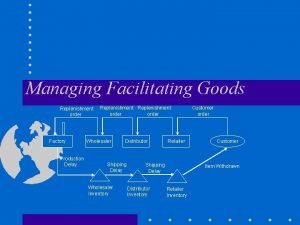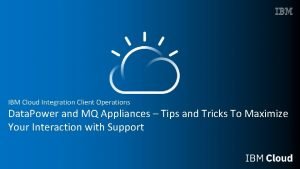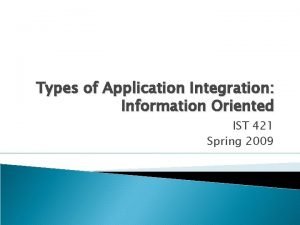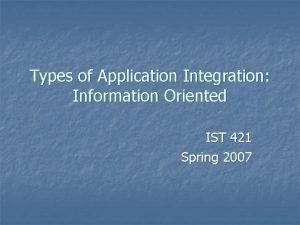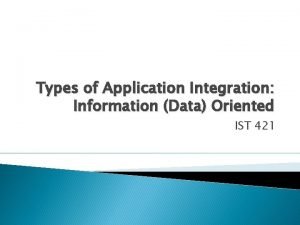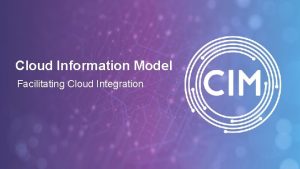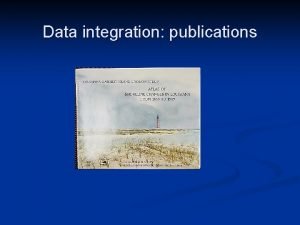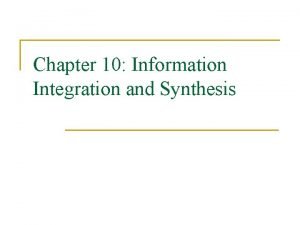Cloud Information Model Facilitating Cloud Integration Cloud Information



















- Slides: 19

Cloud Information Model Facilitating Cloud Integration

Cloud Information Model Vision The Cloud Information Model provides an open, standards-based specification for connecting enterprise products facilitating interoperability. We reduce the barriers to cross-product integration and extend the value proposition of our ecosystems by adopting and contributing to the Cloud Information Model.

Customers expect their environments to “just work” together out of the box… Before After App 1 Reduced integration points App 6 App 2 App 6 App 5 App 3 App 5 App 4 App 1 App 2 App 3 App 4 Multiple point-to-point integrations …but the reality is more complicated.

Challenges without a shared data model More Costly Uncertain ROI Due to custom integrations Due to longer development time Inability to Scale Business functions become silos

What if you could utilize a shared business language for your enterprise and partner data integrations?

Introducing Cloud Information Model The first open standard enabling faster and easier integration of cloud applications Anyone can join Developed as an open standard… Flexible meta-model Modular design, conceptual and schema view, extensible and customizable Build reliable integrations Utilize multiple formats available to communicate between different systems Innovate faster Adopt the modern standard for any use case and reduce time-to-value Standards Compliant W 3 C Stack, Relational Mappings, additional mappings available CIM is an application-agnostic data model produced by an open consortium that delivers a standards-based solution for connecting enterprise products.

Why use CIM? CIM facilitates interoperability Innovate Faster Influence & Collaborate Improve Analytics ● Achieve faster time to value through interoperability. ● Create seamless, customized experiences across cloud-native applications. ● Enable a cross-system view of data and reduce time to build and maintain integrations.

Our Work Program

How we work CIM is organized into components including subject areas, entity groups, entities, and attributes. Subject area: A major business concept identified by the CIM consortium, such as Party. Each subject area contains one or more entity groups. Entity group: A logical grouping of related entities within a subject area, such as Account. Each entity group contains one or more entities. Entity: A unique object that an organization collects information about, such as an Account Contact. An entity is analogous to a standard database table. Attribute: A unique characteristic of an entity, such as Account Id or Contact Email. An attribute is analogous to a standard database field within a table.

Data Model Domains ● Data models are grouped by business process in order from left to right. ● On the Subject Area/Domain Taxonomy slide, you will find a list of horizontal data models under each subject area group header. ● The vertical extensions are data models which extend the model for industry verticals while aligning to the subject area group above. Setup Hire Produce Market Sell Defines who you deal with, for example customer supplier and seller. Activities related to setting up your business. For example, internal business unit and worker. Handling of material that you will be buying, moving and selling. For example, product and inventory product. Activities used to promote your product. For example, marketing campaign and web store. Activities used to sell your product. For example, creation of quotes and opportunities. Serve Fulfill Interact Finance Analyze Activities to provide support for a product sold or serviced. For example, case or a survey. Activities you perform to fulfill an order to a customer. For example, shipment and return order. Activities to track engaging with either end users or other systems. Activities to trace financial information in the company. For example, payment, invoice and expense report. Activities related to analyzing data e. g. analyze patterns, analyze product use, data movement, data changes, customer satisfaction.

Subject Area Release Plan

Mappings, Dataflow & Compatibility

What does it mean to be CIM compatible? Enabling CIM Utilization CIM Alignment/Mapping CIM availability in frameworks, builders or design tools Existing application data models mapped to the CIM standard

Data Flow Between Systems Read json xml Data API http: //. . . List csv Subscribe Format Network Endpoint Operations

Open Discussion – Goals of “CIM Compatibility” Schema Mappings CIM Data Model

Use Cases

CIM in Salesforce Customer 360 Data Manager Map to and consume data from across clouds • CIM exposed in setup UI for data mapping editor • Default mappings included for Service and Commerce (e. g. Account, Contact, Order) • The Customer Resolution Engine (CRE) utilizes CIM mappings to provide resolved customer data • Federated CIM queries provide integrated experiences (e. g. Service for Commerce)

CIM in Mule. Soft Easily create CIM compatible APIs and integrations • Available in Anypoint Exchange • CIM is supported across the entire Anypoint Platform (e. g. Mulesoft Flows, Data. Sense, metadata) • Utilize in API Designer to model CIM compatible APIs • Automated C 360 integration for CIM compatible sources

Join us and help define communication across clouds! https: //cloudinformationmodel. org/ info@cloudinformationmodel. org
 Cloud integration patterns
Cloud integration patterns Teaching vs facilitating
Teaching vs facilitating Facilitate learning session meaning
Facilitate learning session meaning Facilitating learning child and adolescent development
Facilitating learning child and adolescent development Examples of facilitating goods
Examples of facilitating goods Facilitating agencies in marketing channel
Facilitating agencies in marketing channel Specialized channel participants
Specialized channel participants Contactual efficiency examples
Contactual efficiency examples Facilitating learning module 2
Facilitating learning module 2 Factors influencing communication
Factors influencing communication Facilitating cultural change
Facilitating cultural change Elements of flower of service
Elements of flower of service Forward integration and backward integration
Forward integration and backward integration Make or buy continuum
Make or buy continuum Simultaneous integration
Simultaneous integration Ibm cloud integration
Ibm cloud integration Calcium bohr model
Calcium bohr model Portal-oriented application integration
Portal-oriented application integration Information oriented application integration
Information oriented application integration Information-oriented examples
Information-oriented examples




